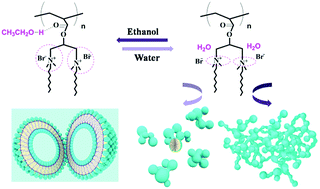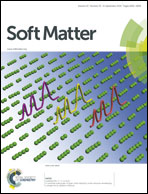Environmentally responsive polymeric materials: effect of the topological structure on self-assembly†
Abstract
A novel amphiphilic homopolymer (PAGC8), containing two hydrophilic head groups and double hydrophobic tails in each repeat unit, has been prepared by solution polymerization and named as “a geminized amphiphilic homopolymer” in this paper, which is capable of self-assembling into various nanoobjects depending on the solution concentration and solvent properties. Characterization of the self-assembly behaviors was carried out by steady-state fluorescence, transmission electron microscopy and nuclear magnetic resonance techniques. Particular emphasis was dedicated to the environmental responsiveness of the assemblies. The morphologies were observed to transform from micelle-type to vesicles on adding a certain amount of ethanol. It is noteworthy that the assemblies were able to trap hydrophilic (rhodamine B) and hydrophobic (Sudan Red) molecules. Subsequently different nanoobjects were found after the encapsulation. To probe the effect of the topological structure on the self-assembly behaviors, the properties of an additional homopolymer with single charge pendant architecture on the backbone were investigated for comparison. Significant differences in structure between the two architectures brought out remarkable variations in aggregates, which were non-responsive to the solvent environment, or encapsulation of molecules. Based on the experimental results, we proposed a possible mechanism of the morphological transitions of the assemblies.


 Please wait while we load your content...
Please wait while we load your content...